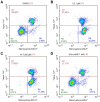Calmodulin inhibitors increase the affinity of Merocyanine 540 for boar sperm membrane under non-capacitating conditions
- PMID: 29887540
- PMCID: PMC6189568
- DOI: 10.1262/jrd.2018-021
Calmodulin inhibitors increase the affinity of Merocyanine 540 for boar sperm membrane under non-capacitating conditions
Abstract
We aimed to test whether the calmodulin (CaM) inhibitors, calmidazolium (CZ) and N-(6-aminohexyl)-5-chloro-1-naphthalenesulfonamide (W-7), can be used to assess lipid disorder by flow cytometry using Merocyanine 540 (M540). Boar spermatozoa were incubated in non-capacitating conditions for 10 min at room temperature with 1 μM CZ, 200 μM W-7, or 1 mM 8-bromoadenosine 3',5'-cyclic monophosphate (8-Br-cAMP). Then, sperm were 1) directly evaluated, 2) centrifuged and washed prior to evaluation, or 3) diluted with PBS prior to evaluation. Direct evaluation showed an increase in high M540 fluorescence in spermatozoa treated with the inhibitors (4.7 ± 1.8 [control] vs. 70.4 ± 4.0 [CZ] and 71.4 ± 4.2 [W-7], mean % ± SD, P < 0.001); washing decreased the percentage of sperm showing high M540 fluorescence for W-7 (4.8 ± 2.2, mean % ± SD) but not for CZ (69.4 ± 3.9, mean % ± SD, P < 0.001), and dilution showed an increase in high M540 fluorescence for both CZ and W-7; 8-Br-cAMP did not induce a rise in sperm showing high M540 fluorescence. Therefore, special care must be taken when M540 is used in spermatozoa with CaM inhibitors.
Keywords: Boar spermatozoa; Calmodulin (CaM) inhibitors; Merocyanine 540 (M540).
Figures



Similar articles
-
AnnexinV binding and merocyanine staining fail to detect human sperm capacitation.J Androl. 2004 Sep-Oct;25(5):797-810. doi: 10.1002/j.1939-4640.2004.tb02858.x. J Androl. 2004. PMID: 15292113
-
Validation of merocyanine 540 staining as a technique for assessing capacitation-related membrane destabilization of fresh dog sperm.Theriogenology. 2015 Jun;83(9):1451-60. doi: 10.1016/j.theriogenology.2015.01.019. Epub 2015 Jan 21. Theriogenology. 2015. PMID: 25796286
-
Capacitation induces cyclic adenosine 3',5'-monophosphate-dependent, but apoptosis-unrelated, exposure of aminophospholipids at the apical head plasma membrane of boar sperm cells.Biol Reprod. 2002 Jul;67(1):340-50. doi: 10.1095/biolreprod67.1.340. Biol Reprod. 2002. PMID: 12080038
-
Detection of cooling-induced membrane changes in the response of boar sperm to capacitating conditions.Theriogenology. 2005 May;63(8):2278-99. doi: 10.1016/j.theriogenology.2004.10.008. Epub 2004 Dec 8. Theriogenology. 2005. PMID: 15826690
-
M540 bodies and their impact on flow cytometric analyses of human spermatozoa.Soc Reprod Fertil Suppl. 2007;65:509-14. Soc Reprod Fertil Suppl. 2007. PMID: 17644988 Review.
Cited by
-
Influence of different cellular concentrations of boar sperm suspensions on the induction of capacitation and acrosome reaction.J Reprod Dev. 2022 Feb 18;68(1):68-73. doi: 10.1262/jrd.2021-075. Epub 2021 Oct 24. J Reprod Dev. 2022. PMID: 34690211 Free PMC article.
-
Sperm Proteome after Interaction with Reproductive Fluids in Porcine: From the Ejaculation to the Fertilization Site.Int J Mol Sci. 2020 Aug 22;21(17):6060. doi: 10.3390/ijms21176060. Int J Mol Sci. 2020. PMID: 32842715 Free PMC article.
-
Effects of MnTBAP on Porcine Semen Cryopreservation and Capacitation.Antioxidants (Basel). 2024 May 30;13(6):672. doi: 10.3390/antiox13060672. Antioxidants (Basel). 2024. PMID: 38929111 Free PMC article.
References
-
- Petrunkina AM, Harrison RA. Cytometric solutions in veterinary andrology: Developments, advantages, and limitations. Cytometry A 2011; 79: 338–348. - PubMed
-
- Sutovsky P. New Approaches to Boar Semen Evaluation, Processing and Improvement. Reprod Domest Anim 2015; 50(Suppl 2): 11–19. - PubMed
-
- Chang MC. Fertilizing capacity of spermatozoa deposited into the fallopian tubes. Nature 1951; 168: 697–698. - PubMed
-
- Austin CR. Observations on the penetration of the sperm in the mammalian egg. Aust J Sci Res, B 1951; 4: 581–596. - PubMed
MeSH terms
Substances
LinkOut - more resources
Full Text Sources
Other Literature Sources

